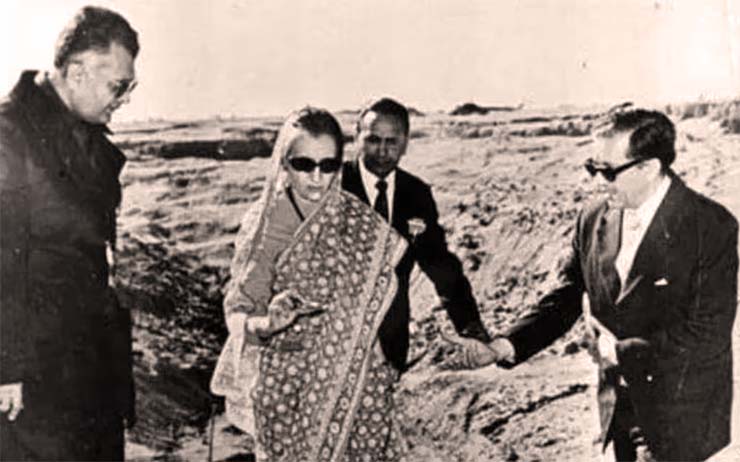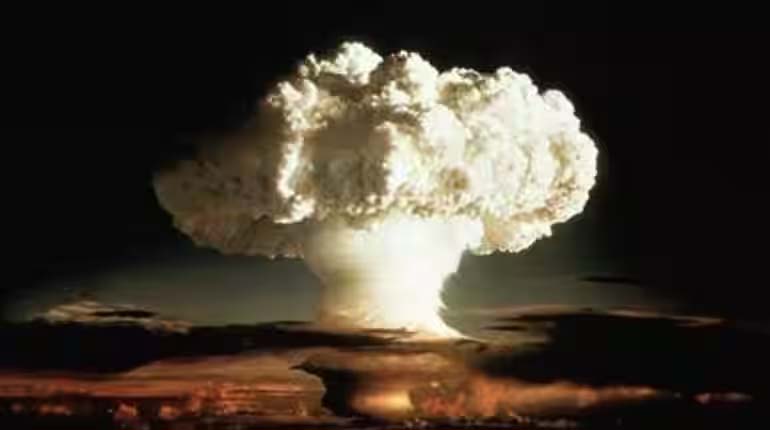
On May 18, 1974, at 8.05 AM IST India successfully carried out its first nuclear test codenamed “Operation Smiling Buddha” at the Pokhran Test Range in Rajasthan. This operation was a significant milestone in history and not only showcased India’s scientific prowess and strategic foresight but also catapulted India into the exclusive club of nuclear-armed states. As we commemorate the 50th anniversary of Operation Smiling Buddha, let’s reflect on the motivations, development, reactions, and legacy of this landmark achievement.
Motivations behind the Nuclear Test
The decision to pursue a nuclear test was influenced by a confluence of geopolitical and security considerations. India faced existential threats in the 1960s, most notably from China and Pakistan. The 1962 Sino-Indian War exposed the vulnerabilities in India’s defence capabilities, compelling policymakers to rethink the country’s strategic posture. The 1971 Indo-Pakistani War further underscored the need for a robust deterrent to safeguard national security.
The geopolitical environment of the Cold War era also played a pivotal role. The nuclear arms race between the United States and the Soviet Union, along with China’s nuclear test in 1964, created a sense of urgency for India to develop its own nuclear deterrent. Furthermore, the pursuit of nuclear technology was seen as a symbol of modernity and scientific advancement, essential for a nation aspiring to assert its independence and influence on the global stage.
Development of the Nuclear Device
The development of the nuclear device was a highly secret exercise carried out by the Bhabha Atomic Research Centre (BARC) under the leadership of Dr Raja Ramanna. The project drew upon the expertise of a dedicated team of scientists, engineers, and technicians who worked tirelessly to overcome numerous technical and logistical challenges.
The decision to proceed with the nuclear test was taken at the highest levels of government, with Prime Minister Indira Gandhi playing a crucial role in approving and supporting the project. The operation was conducted with utmost secrecy to avoid international scrutiny and potential diplomatic repercussions. The code name “Smiling Buddha” was chosen because the test was scheduled to take place on Buddha Purnima, the birth anniversary of Gautama Buddha, symbolising peace and enlightenment.
The device, a plutonium implosion-type bomb, was transported to the Pokhran Test Range in Rajasthan, where meticulous preparations were made for the test. The test site was selected for its remote location, ensuring minimal risk to civilian populations and limited visibility to prying eyes.
Execution of the Test
On the morning of May 18, 1974, the device was detonated successfully, with an estimated yield of around 8 kilotons of TNT. The explosion created a crater and a mushroom cloud, signifying India’s entry into the nuclear age. The test was deemed a success, validating the technical and scientific capabilities of the Indian team.
The announcement of the test was made by Prime Minister Indira Gandhi, who described it as a peaceful nuclear explosion, emphasising India’s commitment to peaceful uses of nuclear energy. This narrative was aimed at countering potential international criticism and projecting the test as a necessary step for national security and scientific progress.
The development of the nuclear device was a highly secret exercise carried out by the Bhabha Atomic Research Centre (BARC) under the leadership of Dr Raja Ramanna. The project drew upon the expertise of a dedicated team of scientists, engineers, and technicians who worked tirelessly to overcome numerous technical and logistical challenges
International Reactions
The test elicited a range of reactions from the international community. While some countries acknowledged India’s scientific achievement, many expressed concern and condemnation. The United States, Canada, and several other Western nations imposed sanctions and suspended nuclear cooperation with India. The Non-Proliferation Treaty (NPT) regime, aimed at preventing the spread of nuclear weapons, faced new challenges as India’s test highlighted the limitations and inequities of the existing global nuclear order.
China, having conducted its own nuclear test a decade earlier, viewed India’s test with apprehension, leading to a recalibration of regional security dynamics. Pakistan, India’s primary rival, accelerated its own nuclear weapons programme in response, setting the stage for a South Asian nuclear arms race.
Despite the international backlash, the test was met with widespread approval within India. It was seen as a bold assertion of national sovereignty and a demonstration of scientific and technological self-reliance. The test bolstered national pride and provided a significant boost to India’s strategic and defence capabilities.

Impact on India’s Nuclear Policy
Operation Smiling Buddha had profound implications for India’s nuclear policy and strategic doctrine. It marked the beginning of India’s journey as a nuclear-armed state, laying the foundation for its subsequent nuclear developments. The test also influenced India’s stance on nuclear non-proliferation and disarmament, shaping its position in international forums.
In the years following the test, India maintained a policy of nuclear ambiguity, refraining from overtly declaring itself a nuclear weapons state while continuing to develop its capabilities. This policy allowed India to navigate the complexities of international diplomacy while preserving its strategic options.
The legacy of Smiling Buddha was further cemented with the Pokhran-II tests in May 1998, when India conducted a series of nuclear tests and openly declared itself a nuclear weapons state. These tests, conducted under the leadership of Prime Minister Atal Bihari Vajpayee, were a direct continuation of the efforts and aspirations that began with Operation Smiling Buddha.
Scientific and Technological Achievements
Operation Smiling Buddha showcased India’s scientific and technological capabilities, marking a significant achievement for the country’s research and development community. The success of the nuclear test was a testament to the dedication and ingenuity of Indian scientists and engineers who worked under challenging conditions to achieve a complex technological milestone.
Operation Smiling Buddha had profound implications for India’s nuclear policy and strategic doctrine. It marked the beginning of India’s journey as a nuclear-armed state, laying the foundation for its subsequent nuclear developments. The test also influenced India’s stance on nuclear non-proliferation and disarmament, shaping its position in international forums
The test also had a transformative impact on India’s nuclear energy programme, providing a boost to research and development in various fields of nuclear science and technology. The knowledge and expertise gained from the test contributed to advancements in nuclear power generation, medical applications, and industrial uses of nuclear technology.
Challenges and Ethical Considerations
While Operation Smiling Buddha was a significant achievement, it also raised important ethical and moral considerations. The pursuit of nuclear weapons poses inherent risks, including the potential for catastrophic destruction and the proliferation of such technologies to unstable regions and actors. The ethical implications of nuclear testing, including the environmental impact and health risks to populations near test sites, remain pertinent issues.
India’s approach to nuclear weapons has been guided by a commitment to responsible stewardship and a no-first-use policy, emphasising the role of nuclear weapons as a deterrent rather than a tool for aggression. This stance reflects an understanding of the grave consequences of nuclear warfare and the need for restraint and caution in the management of nuclear arsenals.
Commemoration and Legacy
As we commemorate the 50th anniversary of Operation Smiling Buddha, it is essential to recognise the multifaceted legacy of this historic event. It was a defining moment in India’s journey towards self-reliance and strategic autonomy, symbolising the nation’s resolve to protect its sovereignty and secure its future.
The anniversary is an opportunity to celebrate the achievements of the scientists and engineers who made the test possible, acknowledging their contributions to India’s scientific and technological advancement. It is also a moment to reflect on the broader implications of nuclear weapons and the importance of pursuing a balanced approach to national security and international stability.
The test also had a transformative impact on India’s nuclear energy programme, providing a boost to research and development in various fields of nuclear science and technology. The knowledge and expertise gained from the test contributed to advancements in nuclear power generation, medical applications, and industrial uses of nuclear technology
Conclusion
Operation Smiling Buddha was a watershed moment in India’s history, marking its emergence as a nuclear-armed state and a significant player on the global stage. The test was a culmination of years of scientific endeavour, strategic planning, and political determination, reflecting India’s aspirations and challenges in a complex and evolving world.
Fifty years on, the legacy of Smiling Buddha continues to shape India’s nuclear policy, strategic doctrine, and scientific progress. It serves as a reminder of the importance of scientific innovation, national security, and responsible stewardship in the pursuit of technological advancements. As we look to the future, the lessons and achievements of Operation Smiling Buddha will continue to inspire and guide India’s journey towards a secure and prosperous future.
–The writer is a seasoned media professional with over three decades of experience in print, electronic, and web media. He is presently Editor of Taazakhabar News. The views expressed are of the writer and do not necessarily reflect the views of Raksha Anirveda















